Last month, I stumbled upon Eli Schwartz’s article titled “Focus on SEO CTR and not just rankings,” and I have to say, it immediately grabbed my attention. As someone who’s been in SEO for years, I’m always looking for content that doesn’t just recycle the same old “best practices” but offers fresh, valuable insights. This article was exactly that.
When I read it, I couldn’t help but feel excited. I thought, “Eli is talking about the undervalued SEO CTR analysis, and we actually have a tool for that at Buddler!” I dove in to see how closely our ideas aligned with Eli’s views. And guess what, they do—and it’s great that Eli highlighted such an underrated topic.
That’s why I wanted to share my thoughts on the article and talk about our tool. While it won’t do all the work for an SEO, it provides insights that are tough to extract manually from Google Search Console data and almost impossible without specialized skills or a developer’s knowledge.
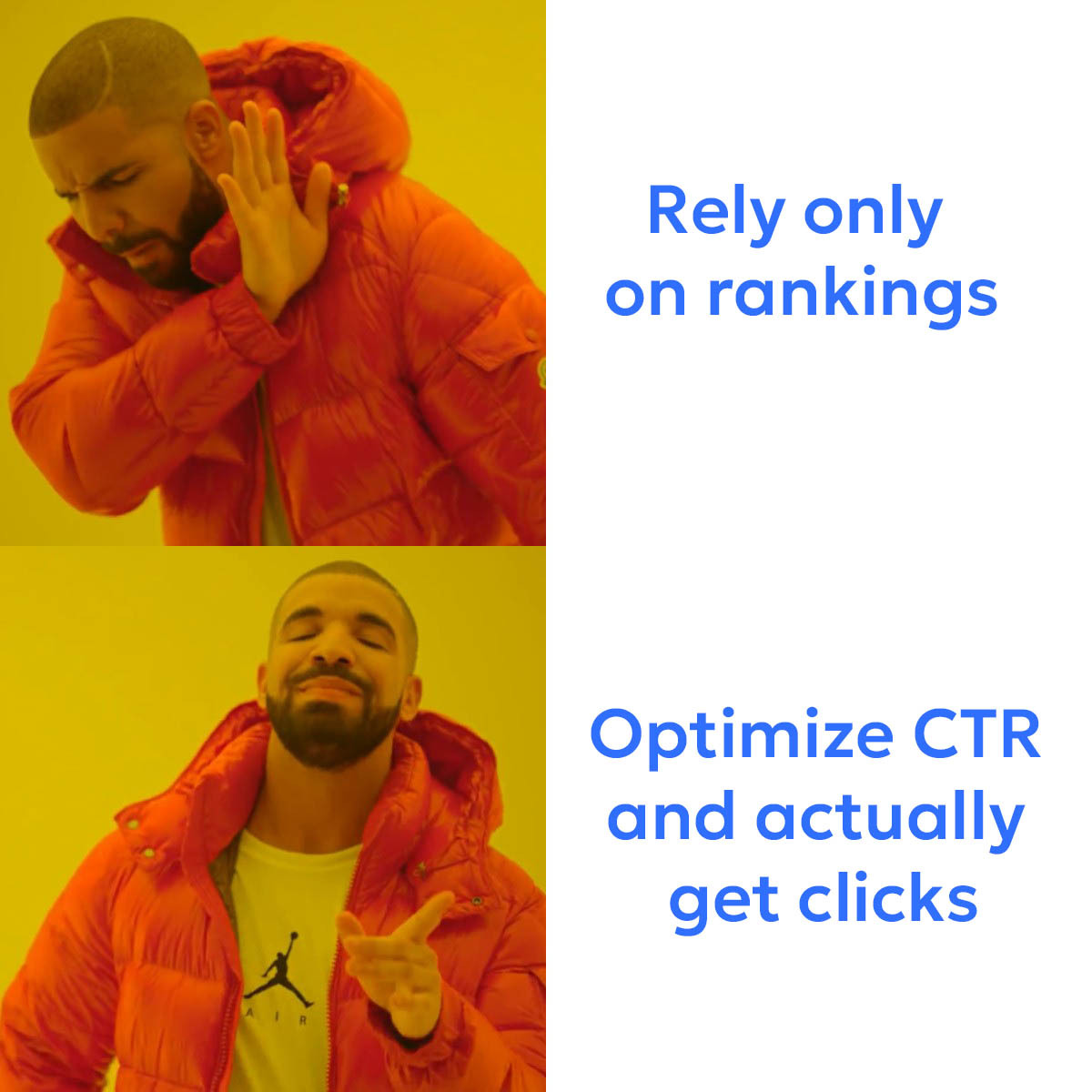
- The main thoughts of Eli Schwartz’s article
- Why is CTR often ignored in SEO?
- CTR analysis solution with Buddler
- CTR as a metric: individual approach
The main thoughts of Eli Schwartz’s article
Eli brings up a crucial topic: CTR (click-through rate) in SEO deserves much more attention than it usually gets. He emphasizes that CTR is not just an indirect metric or SEO side-effect—it’s a key factor that can directly impact rankings. Here are the insights that stood out to me:
- Rankings show potential, but CTR determines success. Eli points out that a high position in search results is just an opportunity, but the CTR shows how well this opportunity is used.
Alas, but this is indeed one way of self-deception for an SEO—to focus only on positions. Positions are not guaranteed; they are only a vanity metric in a vacuum.
- CTR as a ranking factor. According to data that surfaced during the antitrust trial against Google, the search engine does take CTR into account in its ranking algorithms.
Not taking user behavior into account has always been a mistake, but now it’s indefensible.
- CTR as a predictive metric. Eli emphasizes that CTR can be used as an indicator of content performance. High CTR shows that your content is relevant to users’ interests and needs.
Of course, this is not news, but it’s certainly something that should not be forgotten.
- GSC data is the basis of CTR analysis. Google Search Console data allows you to identify pages with abnormal CTR that deviate from your typical averages. This data is key for analysis and the formulation of hypotheses for improvement. It’s also worth paying attention to data from Bing Webmaster Tools, which can implement your analytics and give a broader picture.
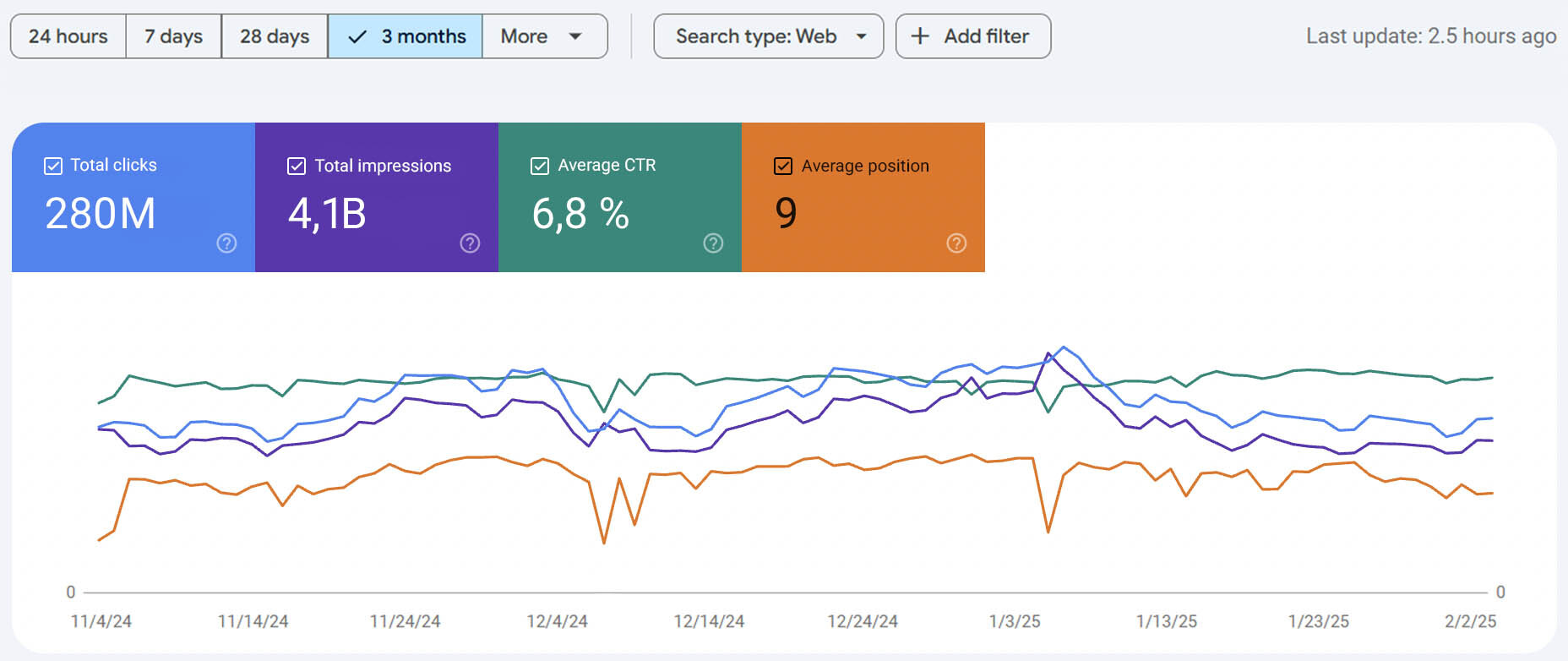
I love GSC and all the possibilities it offers. But I want to add from myself: for anyone who tries to analyze CTR through the GSC interface or pulls data via the GSC API and faces limitations and difficulties with working with the Big Data, there is a better and more effective solution, I will tell below.
- CTR prioritization = optimization for people. CTR optimization focuses on users’ interests, not just on pleasing search engine algorithms.
It’s like a cust dev for a product manager – live and honest reactions to your post.
These thoughts are completely in line with my vision. As an analyst, I often see that both juniors and seniors and dinosaurs do not pay due attention to the SEO metric CTR, but it is here that you can find those «pearls»—fast and affordable growth points.
Why is CTR often ignored in SEO?
From my experience, I can highlight the following reasons:
- No KPI for CTR. If CTR analysis is not fixed as an internal KPI or task to be reported on, it simply doesn’t get priority. This metric is often excluded from the core of reporting, analytics, and SEO strategies, particularly in agency or freelance work. They more often focus on classic and more tangible clear metrics: traffic, positions, and less often leads.
- Lack of popularisation of CTR analysis. CTR analysis is still not commonly included in the standard checklists of SEO agencies and professionals. Many new SEO specialists, just starting out in the field, often learn from their more experienced colleagues and rely on resources from industry leaders. As a result, the focus often shifts to areas like technical SEO, AI-driven content, and link building, while essential topics such as traffic analysis and, specifically, SEO CTR analysis are overlooked. From my own experience, even seven years ago, when I was Head of SEO at a boutique agency, I introduced many analytical processes to the team, and CTR analysis was seen as something new at the time. While much has changed since then, I still find it difficult to come across materials or ready-made solutions that popularise this approach. Perhaps I’m missing something important, but I want to believe that CTR analysis will gain more recognition within the SEO community and become an essential part of daily work for SEO professionals.
- Biased attitude. Some people believe CTR is a purely ‘advertising’ metric and too unstable for organic search. The output for the word CTR is filled with articles on Google Ads, so it’s probably expected.
- Limited resources. When a team or an individual SEO specialist is overloaded, CTR analysis is not a priority. This is especially true in cases where work is billed by the hour, and strict task limitations exist. Under these conditions, projects may become unprofitable, and CTR analysis is often ignored.
CTR analysis solution with Buddler
While working on projects manually, I realized that analytics is rarely predictable – in terms of time spent and results. You could spend a few hours doing complex analysis and uncover valuable insights, or you might spend an entire night on another project and not find anything particularly significant.
I enjoy working with data, but life and sleep are important, too! 😊 Plus, the analysis should be useful and justify the time and resources spent. 💰 Obviously, I needed to find a solution that allows me to analyze CTR quickly, easily, and without unnecessary burden.
Now, that solution exists! Buddler has introduced the SEO CTR Benchmarks Report, which works directly with Google Search Console. My team and I created a tool that performs in-depth analysis of recent and historical website data, generating personalized insights.
What the SEO CTR Benchmarks Report provides
The analysis identifies CTR anomalies, problem areas, and hidden opportunities, as well as calculates the traffic you missed in the last 30 days if CTR hadn’t dropped. All these reports are available in the SEO Analytics Reports.
The data is provided as a preview, along with three in-depth reports:
- CTR Drop Impact. Finds queries with a noticeable drop in CTR, and the search position has changed minimally. These are red flags that show where you are losing traffic. They also highlight queries in the risk zone, which may soon drop in rankings.
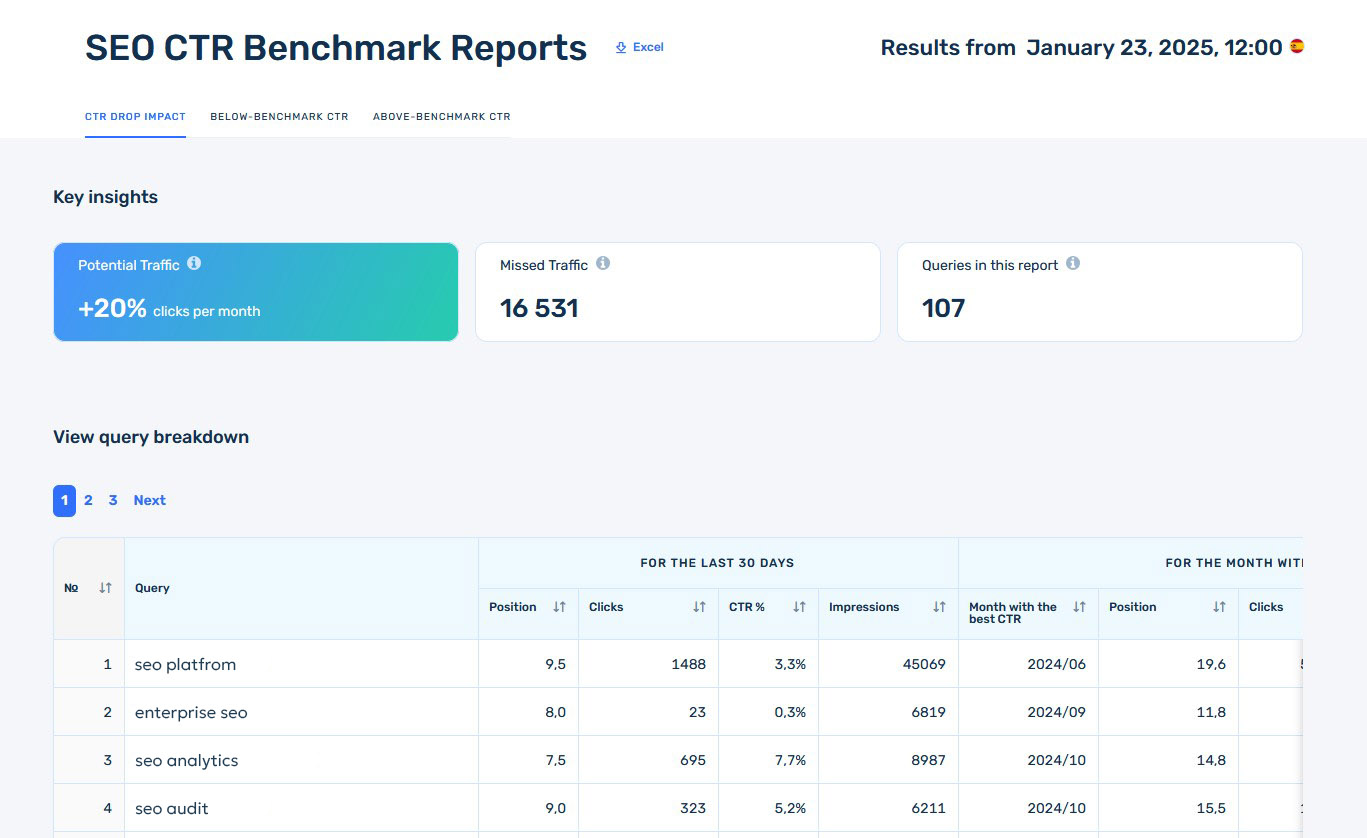
- Below-Benchmark CTR. Shows queries with CTR below the average for other queries with the same search position. These are problem points that can negatively affect results.
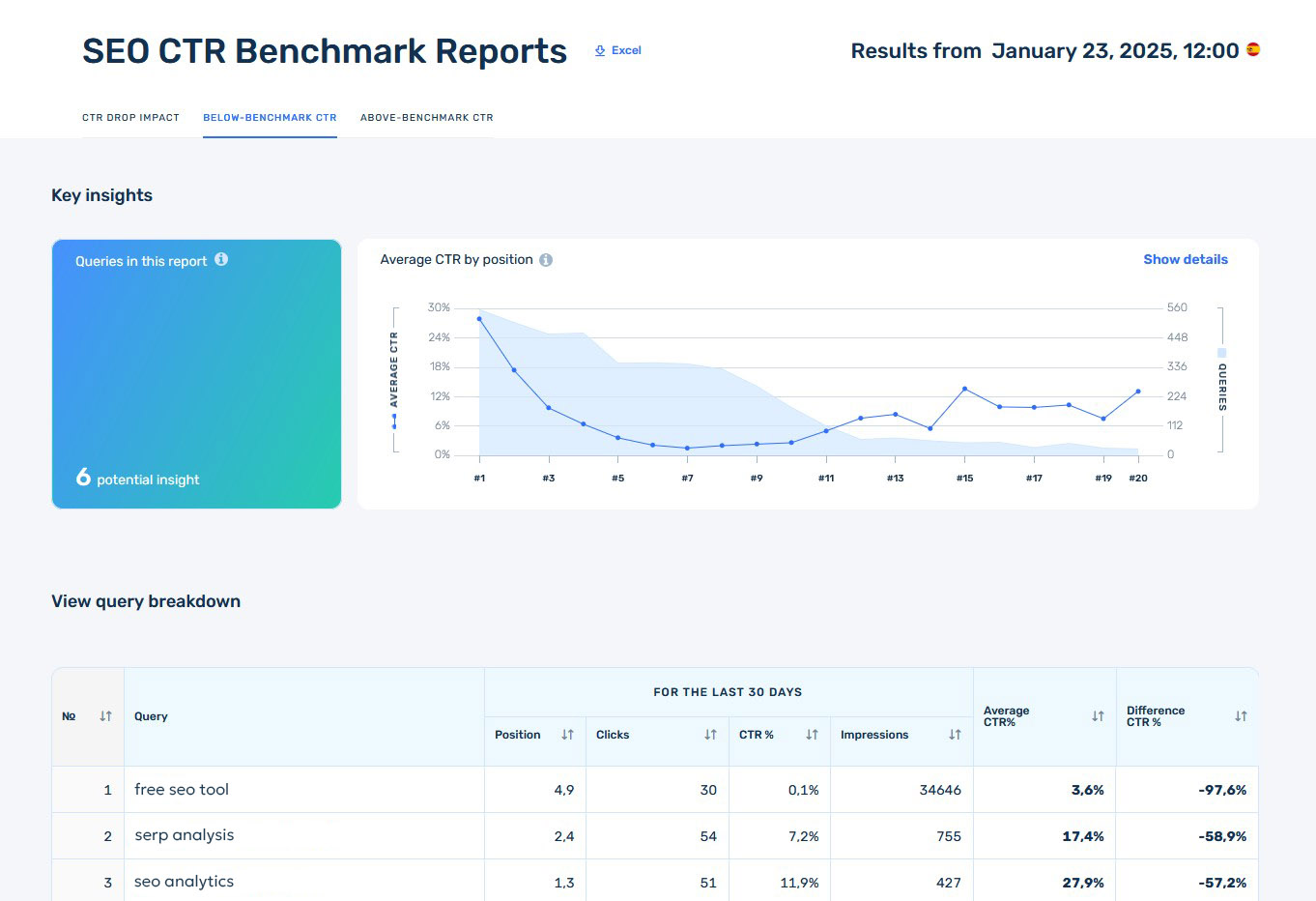
- Above-Benchmark CTR. Identifies queries with a higher CTR than average, even if they are in lower positions. These are your hidden gems, which, with minimal optimization, can bring a noticeable increase in traffic.
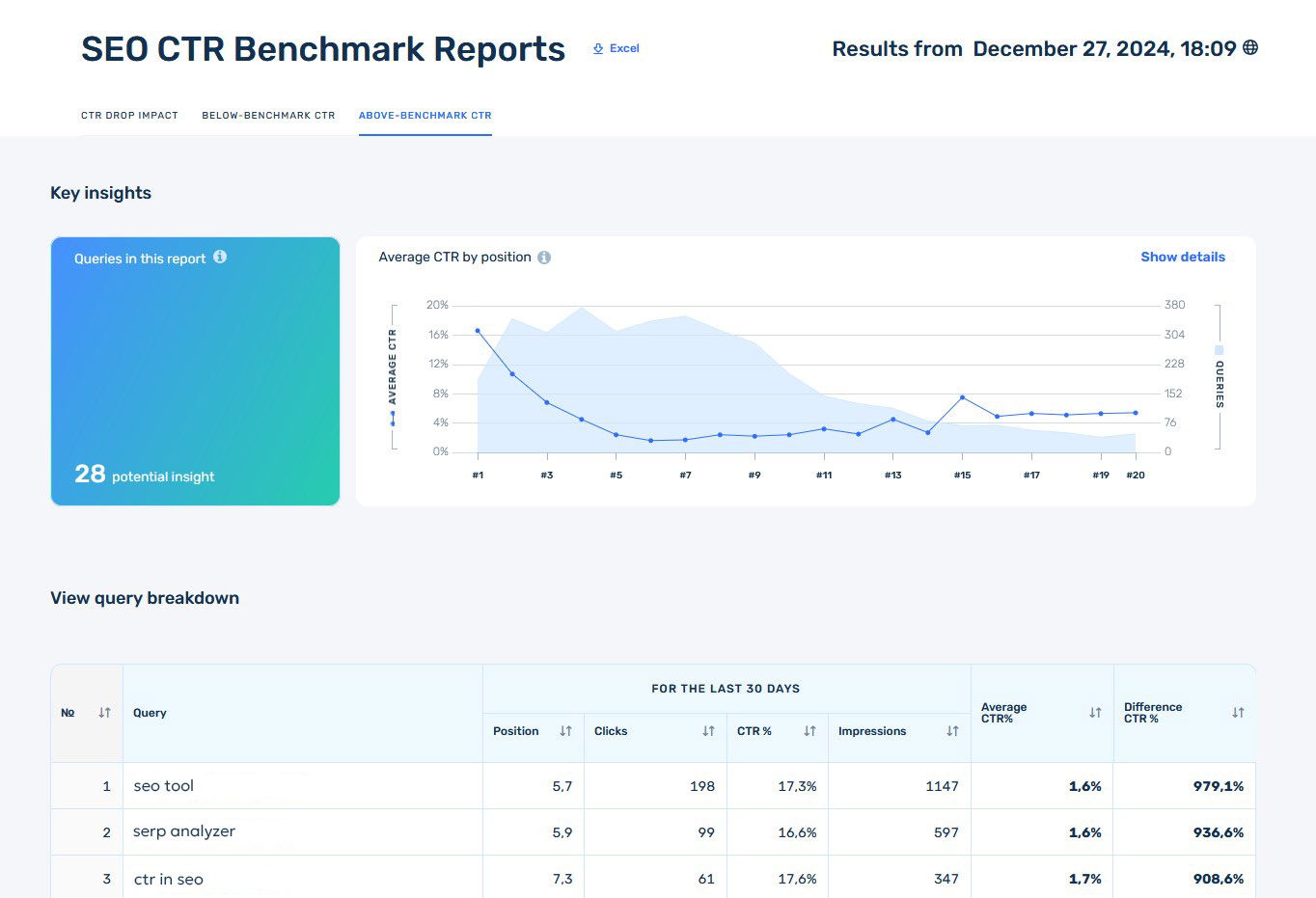
Key advantage: the tool analyzes all site queries from the GSC and identifies only the statistically significant ones in history and their patterns, eliminating not essential so you can focus on what matters.
Also, for international projects, there is an option to run a country-specific audit and see the report generated from local data.
A few more good points
Analytics is still a process with unpredictable results: one site or region might have a ton of insight, hidden traffic, and problems, while another might have minimal opportunities. That’s why at Buddler, we’ve made it possible to run audits in unlimited quantities, with previews available for free. If you’re interested in the numbers and metrics in the previews, you can take the results for credits, which come in a single package for all Buddler products.
No cats in a bag and no bullshit. If you’re interested, watch it. If not, skip it, but know you haven’t missed anything important and can sleep well. 😊
IMPORTANT: Consider the GSC’s capabilities and limitations in your analyses.
- GSC API limitations: For websites generating 1–5 million+ clicks per year (according to Google Search Console), you’ll face limitations with the GSC API, which can result in losing up to 50% of your data. If your site has tens or hundreds of millions of clicks, the API might not return up to 90% of the data. Relying solely on GSC analytics for large sites can lead to inaccurate statistics, as Google provides only a partial dataset, focusing on what it considers most relevant. For sites of this scale, we recommend using Buddler Enterprise and analyzing your data through BigQuery, especially if you’re collecting data that way.
- GSC shows only canonical URLs: You may encounter discrepancies. Anyway – forewarned is forearmed.
- Excluding bot traffic: GSC is not always good at filtering bot traffic, which can inflate the number of clicks. (And of course, if you spin something (don’t do that), you won’t get accurate data)
- Manipulating pages will render the GSC statistics useless: Artificially boosting clicks can create a temporary ranking lift, but it distorts the real picture. If clicks are manipulated, the data becomes unreliable, making it harder to assess actual performance and make informed decisions. Once the manipulation stops, rankings often drop back, and unusual patterns could attract Google’s attention. So, instead of going down that path, it’s better focus on creating quality content and fostering real user engagement. This approach leads to more accurate insights and long-term, sustainable growth. Trust me, it’s the best way forward!
Taking into account all the nuances of Google Search Console data, in my opinion, the most useful thing that can have an SEO specialist for analytics.
CTR as a metric: individual approach
Finally, I’d like to point out that there are many articles on the Internet about ‘What is a good CTR?’. But honestly, this formulation often causes me, as an analyst, an internal protest. There are no universal SEO CTR values. You can’t rely on average data because it doesn’t take into account your project’s specifics.
The real approach to analysis and SEO CTR Benchmarks is to compare yourself to yourself, look for anomalies, test hypotheses, and draw conclusions based on your data.
That’s why I and the Buddler Team created the SEO CTR Benchmarks Report – to help SEOs gain insights where others don’t.
Try Buddler for free
If the topic of CTR analytics resonates with you as much as it does with me and Eli Schwartz, I recommend trying SEO Analytics Reports from Buddler on a free trial.
For Eli and Buddler subscribers, a coupon code EliSchwartz20 adds +20% credits on any paid plan after purchase. This code is valid until March 15, 2025.
Thank you, Eli Schwartz!
Eli, thank you for your article ‘Focus on SEO CTR and not just rankings’. It is exactly the kind of article that makes you think. You raised an important topic that is often overlooked.
I’m very close to your approach – you focus on analytics that change results and make it clear that SEO is not just about positions but about the depth of data insights. That resonated with me.
Your contribution to popularising CTR analytics is important to our community, and I sincerely hope it inspires many SEO professionals to pay more attention to this topic. I give you a lot of respect, and thanks for what you do!
Hi from my guys on our Buddler team! <3
List of sources:
1. Focus on SEO, CTR, and Not Just Rankings by Eli Schwartz
2. Daniel Waisberg at Search Central Live in Zürich
3. Rand Fishkin Experiment – Does CTR Manipulation Work Long-Term?
